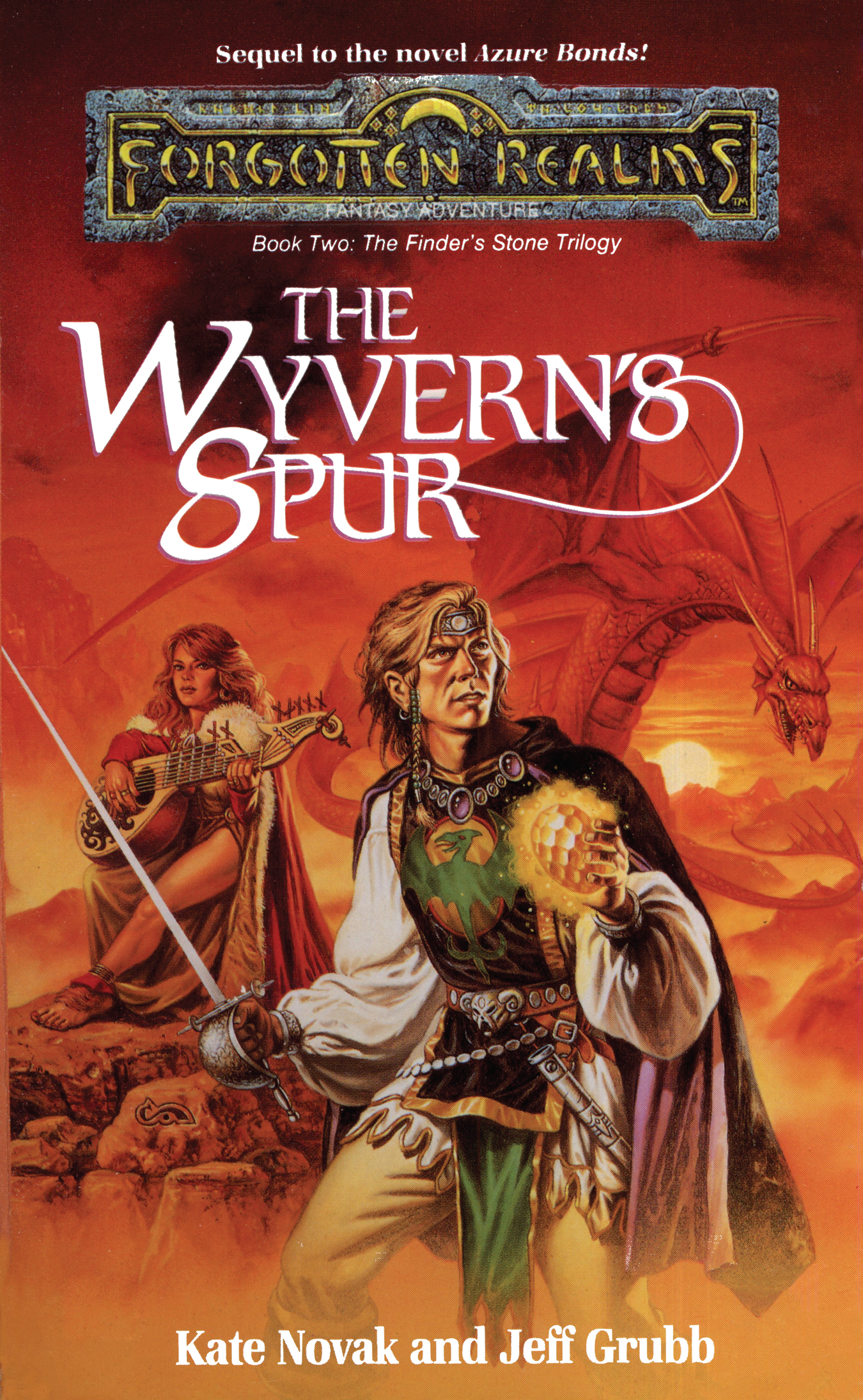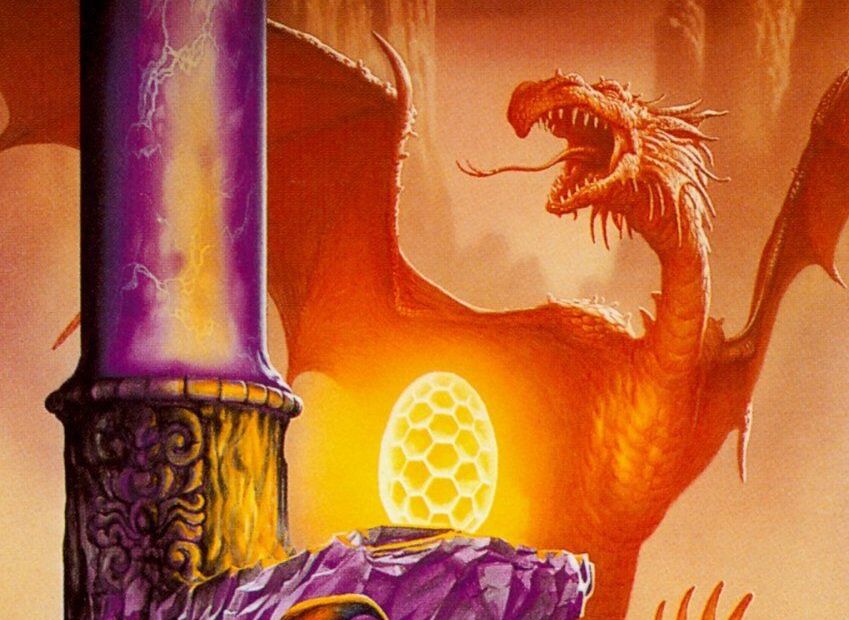The tale of the magically created sellsword and would-be assassin Alias and her boon companion, the saurial paladin Dragonbait, continues in the second volume of the Finder’s Stone trilogy — which, wait a minute…uh…doesn’t actually feature Alias or Dragonbait? At all. But I’ll tell you what The Wyvern’s Spur does contain: the words “wyvern” and “spur.” A lot.
I want to start by telling you I liked the sequel to Azure Bonds a lot because this is going to sound like I’m dunking on it. The Wyvern’s Spur takes pretty much everything you loved about the first book and tosses it aside for an almost completely separate adventure. Gone are most of the first book’s protagonists, including the two main stars; the only one who appears in The Wyvern’s Spur is Olive Ruskettle, the not particularly likable halfling thief. The hero here is Giogi Wyvernspur, the clueless but goodhearted fop who appeared very, very briefly in the first book, and who randomly found the Finder’s Stone while taking a walk.
The Wyvern’s Spur is mainly about the search for the titular spur after it’s stolen from the Wyvernspur family crypt. It’s an artefact with the power to give one member of the family per generation the ability to transform into a wyvern. While other Wyvernspurs have their own reasons for seeking it, Giogi attempts to find it before the evil wizard Flattery, who has his own connection to a major Azure Bonds character and gets his hands on it as part of a belabored scheme to destroy all Wyvernspurs. It’s pretty simple stuff, complicated somewhat by the events of the previous book.
In case any of you who had any plans to read Azure Bonds weirdly didn’t do so within a few months after my look back at it, I need to “spoil” the ending of yet another 30-plus-year-old novel to explain what’s going on in this sequel. When Alias was captured by the various dark forces who created her, each for their own dark reasons, somehow the ritual that was going to put her entirely in their thrall involved nine other unconscious/dead/inoperative copies of her body which were seemingly destroyed when the bad guys were defeated. As we learn in The Wyvern’s Spur, that was not the case.
Not one but two of these Alias clones appear in the book, although they have very different personalities (and character classes) from the original. The first is Jade, a thief who coincidently ran into and has partnered with Olive; the second is Cat, a low-level mage who coincidentally ran into (and was more or less enslaved by) Flattery. Flattery murders Jade when she coincidentally runs into him and he catches her trying to pick his pocket. Look, there are a lot of coincidences in this book.
For instance, almost everyone turns out to be a Wyvernspur, including Flattery and Kat and Jade, the latter two because of a technicality; they (and Alias) were partially created by Finder Wyvernspur, a.k.a. the Nameless Bard, in one of his evil attempts to create a human iPod that would make sure his songs would be sung correctly throughout the ages (with lyrics and music unchanged). The Finder’s Stone was one of those early attempts to contain his work — as was Flattery, who was a clone of Finder who the bard vastly mistreated and threw out for failing to be a good iPod, which is why the wizard hates the Wyvernspurs so dang much.

If all this sounds dire, it’s really not! The Wyvern’s Spur boasts a lot of improvements over its predecessor. Olive is significantly more heroic and less self-interested than in Azure Bonds, in spite of — or maybe because of — spending almost literally the entire first half of the book as a burro. (I’ll explain later.) Giogi is an appealing protagonist in that upper-class but magnanimous doofus Bertie Wooster mode — complete with his own significantly more competent butler, as originated in British humorist P.G. Wodehouse’s utterly delightful Jeeves stories. Cat’s arc of scheming to find the Wyvern’s Spur for Flattery out of fear builds naturally to her decision to throw her lot in with Giogi and Olive instead. (Cat also falls in love with the noble, protective Giogi, but this isn’t so much natural as standard procedure in these sorts of stories.)
Even the fact that practically everyone is a Wyvernspur works in the book’s favour because only someone with the family’s blood could have stolen the artefact. This means there are myriad suspects, especially since almost all the male members of the family — minus Giogi, who helpfully takes after his mother’s side — look so alike it’s even hard to determine their age. This also shrouds Flattery’s identity nicely for much of the book, which keeps the story compelling, even through a somewhat sedate and burro-centric first half. Admittedly, this makes the epic final battle with Flattery feel extremely out of proportion since he ends up bringing a giant castle on a flying mountain to the Wyvernspur home’s front door. However, it ends up with Giogi in wyvern form battling Flattery, who’s transformed into a blue dragon, in the skies, with the former assisted by Olive and a small assortment of heroic Wyvernspurs, which is rather satisfying.
Like R.A. Salvatore’s sophomore effort in the Icewind Dale trilogy, Kate Novak and Jeff Grubbs’ writing and plotting have significantly improved between their first and second novels. The story is more straightforward and less haphazard than in Azure Bonds, and the various twists land solidly, even if there’s a bit of handwaving to prevent characters from getting information too soon. Happily, there’s no gross objectification of women in the book; there is a scene where Giogi’s eyes boggle at the sight of Cat wearing a low-cut dress, but Cat wears it specifically to gain Giogi’s affection as part of her attempt to find and steal the Wyvern’s Spur and it’s only briefly mentioned in a line or two and then dropped, so it doesn’t feel icky. I think the book even passes the Bechdel test, barely, in a few scenes where Olive and Cat discuss the Spur instead of Giogi or Flattery.
[referenced id=”1662027″ url=”https://gizmodo.com.au/2021/01/dungeons-dragons-novels-revisiting-the-legend-of-huma/” thumb=”https://gizmodo.com.au/wp-content/uploads/2021/01/06/ryqzqtkmlzhhngixygfc-300×169.jpg” title=”Dungeons and Dragons and Novels: Revisiting The Legend of Huma” excerpt=”Margaret Weis and Tracy Hickman’s original Dragonlance novels aren’t just considered some of the finest Dungeons & Dragons books ever written, but are some of the most beloved fantasy stories of all time. Richard A. Knaak’s The Legend of Huma is also a Dragonlance novel, but the similarities stop there.”]
So all in all this is a better, more readable novel than Azure Bonds…but I’d be lying if I didn’t admit I’m kind of bummed out Alias and Dragonbait were completely missing in action. I also kind of miss the chaos of the first book, where assassins, dragons, and dark sludge gods could suddenly pop out of nowhere. That craziness is what pushed Azure Bonds to an eight despite its many flaws, but even without it, The Wyvern’s Spur rolls a 10 on a 1d20, making it the best-scored book in my “Dungeons & Dragons & Novels” series — and leaving me excited to (eventually) get to the third and final book in the trilogy, Song of the Saurials. Especially since Alias and Dragonbait will be back. I have to imagine those singing saurials might be a little miffed to discover Alias has effectively named their fellow lizardman “Wyrm Chow.”

Assorted Musings:
- If you’re not up on your Monster Manual, a wyvern is like a smaller dragon with a poisonous tailstinger instead of a breath weapon.
- If you’re thinking the artefact is a spur, like something knights put on their boots to ride their horses, you are incorrect: The spur is a bony, horn-like part of a wyvern’s leg, something many real-world birds also have. This means the Wyvernspurs have been carrying around a hunk of a deceased creature for centuries, which is super-gross. At one point Olive even mistakes it for a hunk of dried meat.
- I have no idea why this is called the Finder’s Stone trilogy, as the stone has virtually no role in either The Wyvern’s Spur or Azure Bonds. The only magic power it seems to have is shining a light that wards off a few monsters. Maybe it’ll come into play in Song of the Saurials?
- At the end of Azure Bonds, Olive meets the centuries-old Finder/Nameless Bard, who has repented of his evil iPod-making ways after seeing the newly created, newborn-minded Alias instinctually care for Dragonbait. That’s all well and good, but then The Wyvern’s Spur comes around and reveals Finder was an enormous piece of shit who found no such affection for the imperfect clone of himself he created, Flattery. It retroactively makes his “redemption” really unearned and frustrating.
- As annoying as Flattery’s name is, I still think Phalse, one of the villains from the previous book, has a stupider name. If you’re going to be that obvious a character is a bad guy, just go ahead and spell the word correctly.
- Amazon lists The Wyvern’s Spur as being part of The Finder’s Stone trilogy, which really threw me for a loop when I started reading.
- A “scantily clad” statue of the goddess Selune gets delivered to Giogi’s estate, which was done by an artist named Cledwyll, an obvious reference to and good-natured dunk on Azure Bonds and The Wyvern’s Spur cover artist Clyde Caldwell.
- Oh! So the reason Olive turns into a burro is because she gets her hands on Giogi’s purse at the beginning of the book, long before the Spur shenanigans pop off. Being a doofus who has had his pockets picked many times before, Giogi had a wizard cast a spell on it so the next person who opened it who wasn’t him would transform into an arse as punishment …because they would metaphorically be an arse for stealing his money.
- Something I completely didn’t realise was a plot hole until I was writing this article: Why the hell does Flattery want with the Wyvern’s Spur when he can already turn into a dragon?
- Next time, of D&D&N: Saga of Old City, the second novel set in the world of Greyhawk, and the first novel by the Dungeons & Dragons creator Gary Gygax! Thanks to Christopher M. for the assist, because Wizards of the Coast seems very pointedly to not be interested in making ebook editions of them. I am, frankly, a little worried.
